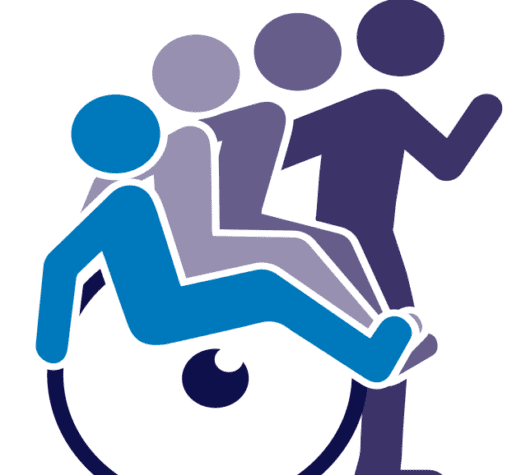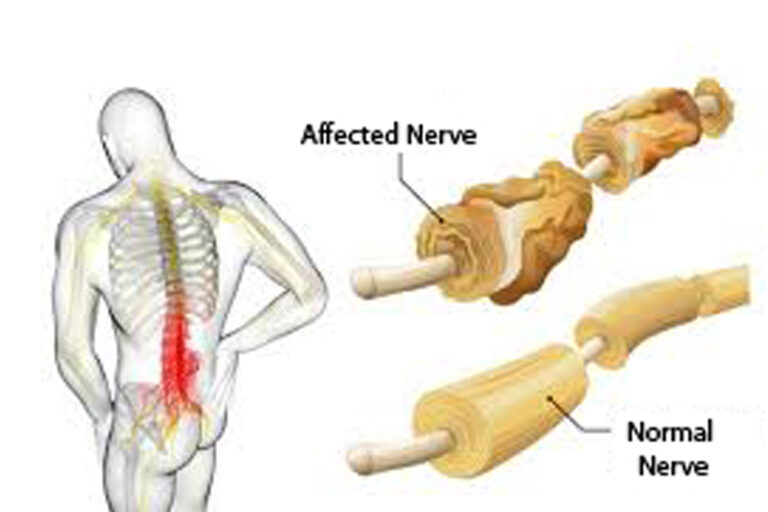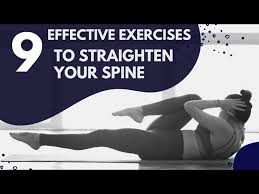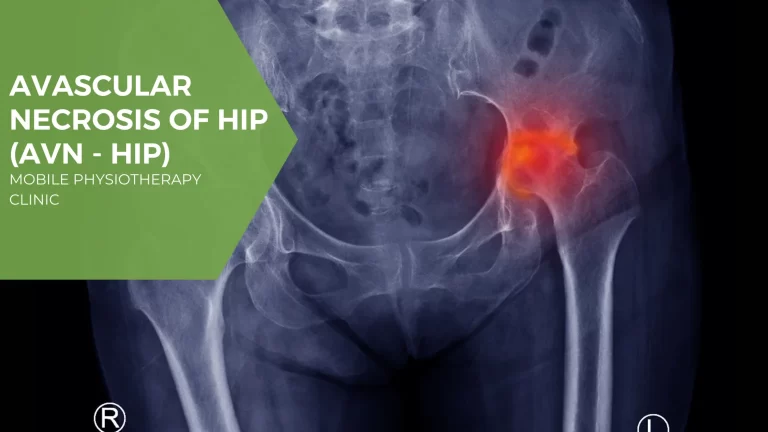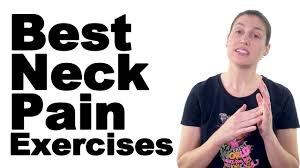11 Best Exercises for Back Pain
Table of Contents
Introduction:
One of the most prevalent issues that may impact individuals of all ages is back pain, which is frequently caused by bad posture, weak muscles, or a sedentary lifestyle. Because it strengthens the spine, increases flexibility, and decreases stiffness, regular exercise is one of the best strategies to manage and prevent back pain.
The correct set of motions can promote improved posture, reduce stress, and increase general mobility. The top 11 back pain exercises that are easy, safe, and very successful in fostering long-term relief and a stronger back will be covered in this book.
Benefits of the Top 11 Back Pain Exercises:
Beyond simply easing agony, there are other health advantages to incorporating back pain exercises into your regular regimen. These exercises are intended to strengthen your back by focusing on the core, surrounding muscles, and spine. Among the main advantages are:
- Pain relief: Back muscles can become less stiff and tense with the aid of mild stretches and strengthening exercises.
- Increased Flexibility: Consistent practice increases the spine’s and the surrounding joints’ range of motion, which facilitates everyday motions.
- Better Back and Core Muscles: A strong core lessens the strain on your spine and minimizes the chance of chronic pain.
- Improved Posture: By teaching your body to maintain normal alignment, exercises help you avoid hunching and slouching.
- Improved Circulation: Exercise increases blood flow, which speeds up the repair of tissues and muscles.
- Preventing Future Problems: Exercises that increase mobility and strength reduce the chance of developing persistent back pain and other spinal disorders.
- Improved Quality of Life: Being more mobile and experiencing less pain allows you to continue being active and self-sufficient in your everyday activities.
11 Best Exercises for Back Pain
11 Best Exercises for Back Pain:
Child’s Pose:
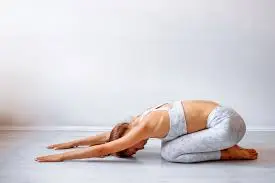
Child’s pose is a mild resting position that opens the hips, eases lower back tension, and lengthens the spine. Relaxing the mind and relieving stress in the neck, shoulders, and back can be achieved by folding the torso forward with the arms outstretched or lying on the sides.
This position is a great option for both warm-up and cool-down routines since it is particularly helpful for reducing back pain, increasing flexibility, and encouraging deep relaxation.
Knee to Chest Stretch:
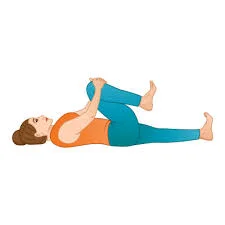
A quick and easy exercise that helps release tension and relax the lower back muscles is the knee to chest stretch. This stretch lengthens the spine, increases blood flow, and eases lower back and hip stiffness by gently drawing one or both knees toward the chest.
After extended durations of standing or sitting, it is particularly helpful for reducing back pain, increasing flexibility, and encouraging relaxation.
Piriformis Stretch:
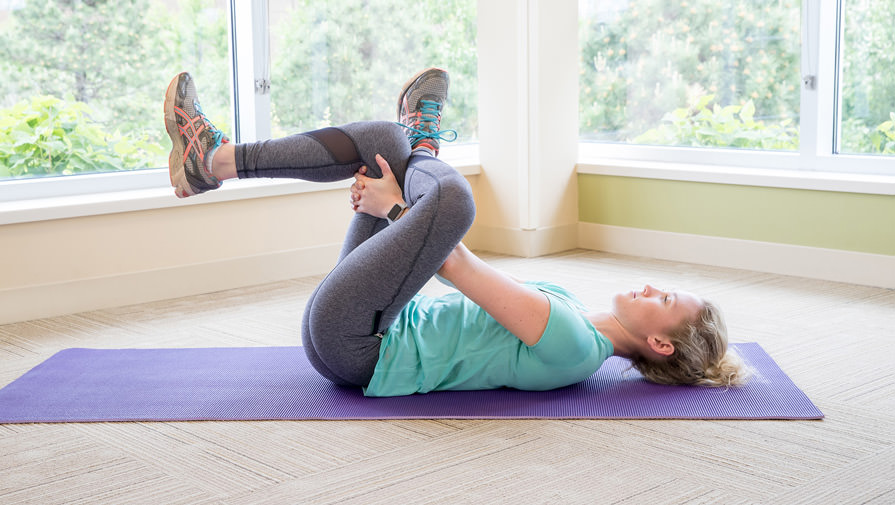
The piriformis muscle, which runs deep in the buttocks and occasionally presses against the sciatic nerve, producing stiffness or pain that radiates down the leg, can be greatly relieved by the piriformis stretch.
This stretch relieves hip tightness, increases range of motion, and lessens sciatica or lower back pain. Frequent practice can help maintain good posture, improve hip flexibility, and avoid muscular imbalances that frequently cause back pain.
Cobra Pose:

A mild backbend, cobra position serves to stretch the muscles in the chest, shoulders, and abdomen, strengthen the spine, and enhance posture. This posture improves spine flexibility, eases lower back strain, and opens up the lungs by raising the chest while maintaining a grounded pelvis.
Cobra posture is particularly helpful for people who have back pain or spend a lot of time sitting down since it may also improve blood circulation, stimulate the abdominal organs, and lessen stiffness.
Cat-Cow Pose:
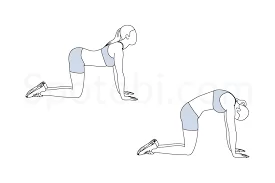
The Cat-Cow Pose is a mild yoga sequence that warms and stretches the spine by combining two poses. The “cat” position, which helps relieve stress in the spine, begins on your hands and knees and entails curving your back, tucking your chin to your chest, and bringing your belly inward.
The next posture is the “cow,” which involves expanding your chest, raising your head and tailbone upward, and arching your back. Alternating between these two postures eases neck and back stiffness, improves posture, relaxes the spine, and improves posture.
Seated Forward Bend:
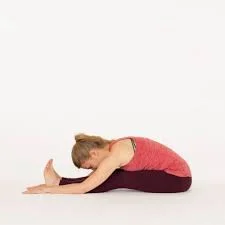
A soothing yoga practice that offers a deep stretch for the lower back, spine, and hamstrings is the Seated Forward Bend. Practice it by sitting with your legs straight out in front of you, keeping your back straight, and reaching for your feet while slowly hunching forward from the hips.
Keep your spine long and let your hands rest on your shins, ankles, or toes, wherever you can reach them comfortably. This posture is great for relieving physical and emotional stress because it promotes relaxation, increases leg flexibility, and eases back strain.
Low Lunge:
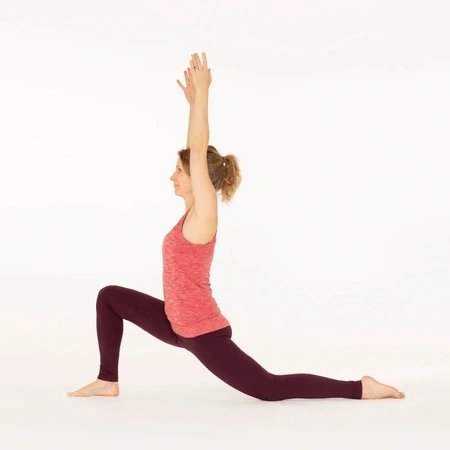
A great stretch for the hips, thighs, and groin, the Low Lunge also helps with posture and balance. With one foot forward and the other leg extended back, start in a lunge stance, placing the back knee on the ground. As you raise your chest, softly move your hips forward while keeping your front knee stacked over your ankle.
For a more thorough stretch, you can place your hands on the floor, on your front thigh, or up above. This posture is great for releasing tension in the lower back, loosening up tight hip flexors, and increasing lower body flexibility in general.
Bird Dog exercise:
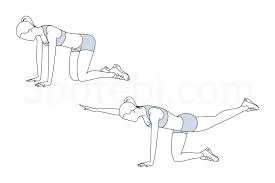
In addition to strengthening the core, the Bird Dog exercise works the shoulders, hips, and back to increase balance and stability. With your knees behind your hips and your hands firmly beneath your shoulders, start on all fours. Maintaining a neutral spine and level hips, slowly stretch your right arm forward and your left leg back. Hold for a while, then flip sides and go back to the beginning position. This deliberate action is particularly useful for lowering back pain and enhancing general body stability since it strengthens the core, maintains spinal alignment, and improves coordination.
Superman Pose:
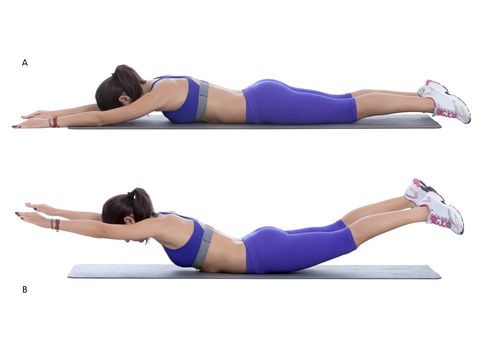
A straightforward yet powerful exercise that tones the shoulders, core, glutes, and lower back is the Superman Pose. It is performed by lying face down on the floor with your legs stretched back and your arms straight out in front of you. Using your back and glute muscles, take a breath while you raise your arms, chest, and legs off the ground all at once.
Hold for a moment, then slowly lower yourself back down. By focusing on the muscles that support your spine, this position helps you develop better posture, increase spinal stability, and lower your chance of developing back pain.
Partial Sit-Ups:
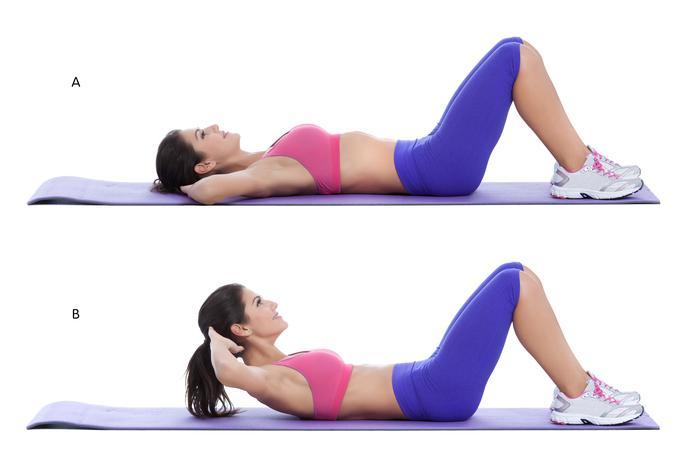
An effective core exercise that targets the muscles of the abdomen without overtaxing the lower back is the partial sit-up. To do them, place your feet flat on the floor, bend your knees, and lie flat on your back. For support, place your hands behind your head or across your chest.
Using your core, slowly raise your head, shoulders, and upper back off the ground. Then, manage your descent back down. This activity has a lower range of motion than complete sit-ups, which makes it safer for the spine while still strengthening and stabilizing the core.
Side Plank:

The Side Plank is an effective core workout that strengthens the shoulders, hips, and legs in addition to targeting the obliques. To do it, stack your feet on top of one another while lying on your side with your legs outstretched. Raise your hips off the floor so that your head and heels form a straight line, placing your lower elbow just beneath your shoulder.
Maintain the posture while maintaining a stable body and an active core. This exercise is great for posture and injury prevention since it increases balance, strengthens the core, and supports the spine.
Conclusion:
To sum up, adding these exercises to your regimen will significantly increase your strength, flexibility, and spinal support while also easing pain and stiffness. While strengthening exercises like the Bird Dog, Superman Pose, Partial Sit-Ups, and Side Plank develop core stability and preserve the back, gentle stretches like the Cat-Cow, Seated Forward Bend, and Low Lunge aid in tension release and improve mobility. Regular practice of them benefits long-term back health and general well-being in addition to improved posture and balance.
FAQs
Maintaining a neutral arm position, keeping your feet flat on the floor with your knees at a 90-degree angle, and using a cushion to assist the natural curvature of your lower back are all ways to sit with back pain. To maintain relaxed muscles, take 30-minute rests to stand and stroll.
Indeed, there is a substantial hereditary component to back pain; research indicates that heritability estimates for low back pain (LBP) range from 30% to 68%, according to many sources. Numerous elements of back pain, such as disc degeneration, pain perception, and psychological issues, are influenced by this hereditary propensity. Back pain is influenced by several variables, including lifestyle, environment, and physical stress, in addition to heredity.
Try sleeping on your side with a cushion between your knees to maintain your spine in alignment, or on your back with a pillow between your knees if you have back pain. If you must sleep on your stomach, lie a cushion beneath your pelvis and use a flat pillow or none at all. To maintain a neutral spine posture, make sure your pillows are suitable for your head and neck and that your mattress provides balanced support.
Avoid heavy lifting, workouts requiring quick twisting or spinal flexion, and high-impact activities if you have back pain. Crunches, sit-ups, toe touches, deadlifts, and jarring workouts like burpees and sprinting are among the specific motions to stay away from. Sports like basketball, racquet sports, and golf that require twisting, high-impact leaping, or abrupt direction changes should also be temporarily avoided.
For the first six weeks after the pain starts, avoid doing any tasks that require you to move heavy objects or twist your back. Avoid exercising in the days immediately after the onset of pain. Start exercising again gradually after two to three weeks. You can learn which workouts are best for you from a physical therapist.
Although there is no permanent solution for back pain, some operations for underlying issues, customized physical therapy, and less invasive procedures can provide long-lasting relief by addressing the problem or preventing pain signals. By strengthening muscles, lowering inflammation, and enhancing alignment, non-surgical treatments, including yoga, acupuncture, heat/cold therapy, exercise, and proper posture, can also help avoid recurrence.
Osteoporosis. If the bones become brittle and porous, the vertebrae in the spine may break painfully. Axial spondyloarthritis is another name for ankylosing spondylitis. Some of the spine’s bones may merge as a result of this inflammatory condition.
Bent Over Barbell Row
A common back exercise and perhaps a favorite for any back workout is the bent-over row, often known as the barbell row. The Rhomboids, Teres Major + Minor, Posterior Deltoids, and Trapezius are the main muscles that will be worked during this complex exercise.
Large research and reviews have shown that paracetamol is no more beneficial than a placebo in lowering pain, disability, or increasing quality of life for illnesses like acute or chronic low back pain, which is why it is not advised for back pain. Although it has historically been used as a first-line treatment, research indicates that it has no discernible benefits for back pain and still has hazards; therefore, non-pharmacological methods like exercise are preferable.
Acute back pain lasts a few days to a few weeks, whereas chronic back pain lasts more than 12 weeks. With home care, the majority of acute back pain goes away on its own in four to six weeks. You should see a doctor, though, if your back pain is severe, doesn’t go away with at-home treatment after a few weeks, or is accompanied by numbness or weakness in your legs.
Red flags for back pain indicate potentially dangerous underlying problems and call for an immediate medical evaluation. These comprise neurological signs like paralysis, numbness, or loss of control over the bowels or bladder; constitutional symptoms like fever, chills, or unexplained weight loss; and history-related variables like cancer, chronic steroid use, age over 50, or recent serious trauma. Additional warning signs include the existence of a structural deformity, pain at night or during rest, and increasing, non-mechanical pain that doesn’t go away with rest.
Applying a cold pack, taking over-the-counter painkillers like acetaminophen or ibuprofen, and doing mild stretches like the knee-to-chest or cat-cow posture can all help ease back pain quickly. After the first 48 hours, avoid activities that worsen your pain and think about using heat treatment or a warm bath to calm your muscles. Future pain can also be avoided by maintaining proper posture and core strength via consistent, low-impact exercise.
Yes, a dull ache can be caused by constipation when the backed-up stool in your colon presses against the nerves in your lower back. Muscle tension caused by straining during bowel movements might further worsen the pain. Severe fecal impactions can result in excruciating back pain and need to be treated right away.
Gynecological conditions such as endometriosis, fibroids, ovarian cysts, menstrual cramps, and pregnancy can cause lower back pain in women. Mechanical factors, including sacroiliac joint dysfunction, ruptured discs, or muscular strains, can also cause it. Back pain may also be caused by hormonal changes associated with menopause and menstruation.
Because they preserve spinal alignment and lessen strain on the back, sleeping on your side with a cushion between your knees or on your back with a pillow between your knees is the ideal sleeping position for back pain. By creating more room between the vertebrae, a slightly curled fetal posture can also be beneficial. Using the proper pillows for neck and lumbar support is essential to maintaining a pleasant and straight spine, regardless of the posture.
Yes, yoga is generally seen as helpful for back pain since it helps improve posture, strengthen core muscles, promote flexibility, and lower stress levels. Yoga is advised as a first-line treatment for persistent low back pain by organizations such as the American College of Physicians; nevertheless, appropriate form and moderate movements are essential to prevent harm. Before beginning a new yoga program for back pain, always get advice from a physician or yoga instructor.
Degenerative changes like arthritis or bulging discs, poor posture, or a lack of physical fitness that puts stress on the spine, and muscle or ligament strains from heavy lifting or abrupt movements are common causes of back pain. Osteoporosis and the fractures it generates, inflammatory diseases like ankylosing spondylitis, and, less frequently, more serious problems such as tumors, infections, or pain that is transferred from other organs are some other reasons.
The McGill Big 3 can appear to be easy workouts at first. Don’t be deceived, though; they are powerful. Every exercise focuses on different back and core muscles, which helps to increase stability and lessen pain.
After sneezing, apply a heat pack or ice pack to the affected area, use over-the-counter (OTC) pain medicines, and do low-impact exercises like walking or light stretching to ease muscle tension and increase blood flow. When sneezing, keep your posture straight and get help if the pain is severe, persists for more than a few weeks, or is accompanied by other symptoms.
While low-impact sports like walking, swimming, and stationary riding increase endurance and support the spine without jarring it, exercises like the knee-to-chest stretch, cat-cow stretch, and glute bridges can help relieve back pain by strengthening core muscles and boosting flexibility. It’s important to do these exercises slowly and to stop if you experience severe pain. If your pain continues or becomes worse, you should see a doctor.
References:
- Gaikwad, T., & Gaikwad, T. (2024, March 29). 11 top exercises for lower back pain. KCM Clinic – Klinika Leczenia Otyłości, Poradnia Medyczna, Szpital – Jelenia Góra, Wrocław. https://kcmclinic.com/11-top-exercises-for-lower-back-pain/
- Back exercises in 15 minutes a day. (n.d.-c). Mayo Clinic. https://www.mayoclinic.org/healthy-lifestyle/adult-health/in-depth/back-pain/art-20546859
- Cronkleton, E. (2020b, August 25). The 10 best yoga poses for back pain. Healthline. https://www.healthline.com/health/fitness-exercise/yoga-for-back-pain
- Cadman, B. (2025c, April 14). How to strengthen the lower back. https://www.medicalnewstoday.com/articles/323204
- Physio, B. (2025b, June 30). 13 exercises for lower back pain that you can do anywhere. Benchmark Physio. https://benchmarkphysio.com.au/physiotherapy-exercises-for-lower-back-pain/
- Fit, C. (2022a, July 21). 11 exercises to relieve your back pain. blog.cult.fit. https://blog.cult.fit/articles/exercises-to-relieve-your-back-pain
- Fannon, J. (2025, July 21). Our top physio exercises for lower back pain. Physio and Exercise Lab. https://physioandexerciselab.com.au/best-physio-exercises-for-lower-back-pain/
